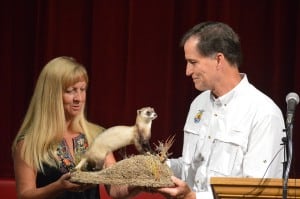Share this article
Black-footed ferret recovery comes full circle
Twenty-nine years ago, biologists traveled to the ranching community of Meeteetse in Wyoming to trap the last few black-footed ferrets (Mustela nigripes) in existence. Now, the descendants of those ferrets are back in their ancestral home, thanks to a captive breeding effort that rescued the species from extinction. The ferrets were released at the site last week, amid celebration by state and federal wildlife professionals and members of the local community.
“Symbolically, it was a very special occasion, because black-footed ferret recovery had literally gone full circle,” said Ryan Moehring, a spokesperson for the U.S. Fish and Wildlife Service. “Everyone was wearing ‘welcome home, black-footed ferret’ t-shirts.”

U.S. Fish and Wildlife Service Director Dan Ashe presents a stuffed black-footed ferret mount to Kris Hogg, whose family rediscovered the species on their ranch 35 years ago. ©Ryan Moehring/USFWS
Black-footed ferrets are small, black-masked members of the weasel family that prey on prairie dogs and live in the rodents’ burrows. By the start of the 1980s, the species was thought to be extinct, wiped out by habitat loss, prairie dog extermination efforts, and a disease called sylvatic plague that humans brought from Europe. Then, in 1981, a ranch dog named Shep caught a ferret and brought it home to its family in Meeteetse. At first, the family didn’t know what the animal was, but a taxidermist quickly recognized the endangered creature and notified local wildlife agents.
When biologists explored the site, they found a population with more than 100 ferrets. But like other ferret populations before them, the Meeteetse ferrets soon began perishing from plague. To save the species, researchers took the last of the ferrets out of the wild and began breeding them at several facilities around the country.
Now, the U.S. Fish and Wildlife Service and its collaborators have raised hundreds of ferrets in captivity and released them at sites in the U.S., Canada and Mexico. Meeteetse is the 28th release site, and it carries a special symbolism. The researchers brought 35 ferrets to the historic event — one for each year since the species was discovered. They also presented the ranch family with a stuffed ferret as a gift, since the family didn’t get to keep the original carcass they brought to the taxidermist.
Black-footed ferrets still face threats in the wild, primarily from sylvatic plague. All captive-bred ferrets are vaccinated before being released, but their offspring are vulnerable to the disease when it sweeps through prairie dog towns. Researchers are working to combat the threat with an experimental oral vaccine, which they hope to distribute to prairie dogs using drones.
It’s been just over a week now since the ferrets were released at Meeteetse, and there is no word yet on how they are faring, says Moehring. The nocturnal, burrow-dwelling creatures are difficult to study, but researchers will do their best to check on them this fall or winter. In the meantime, everyone is rooting for them.
“Human beings have this amazing capacity for destruction, but they also have this amazing capacity for empathy and for doing what’s right — for correcting wrongs that we may have committed,” Moehring said. “We’re doing that with ferrets. We’re putting a species back on the landscape that deserves to be there.”
Header Image:
A black-footed ferret prepares to venture into its new home on a ranch at Meeteetse, Wyoming.
©Ryan Moehring/USFWS








